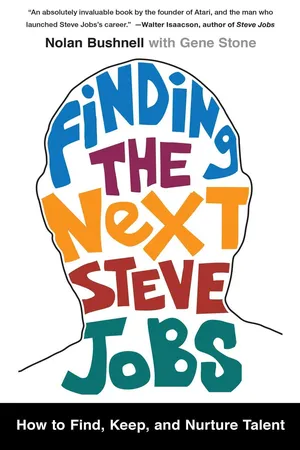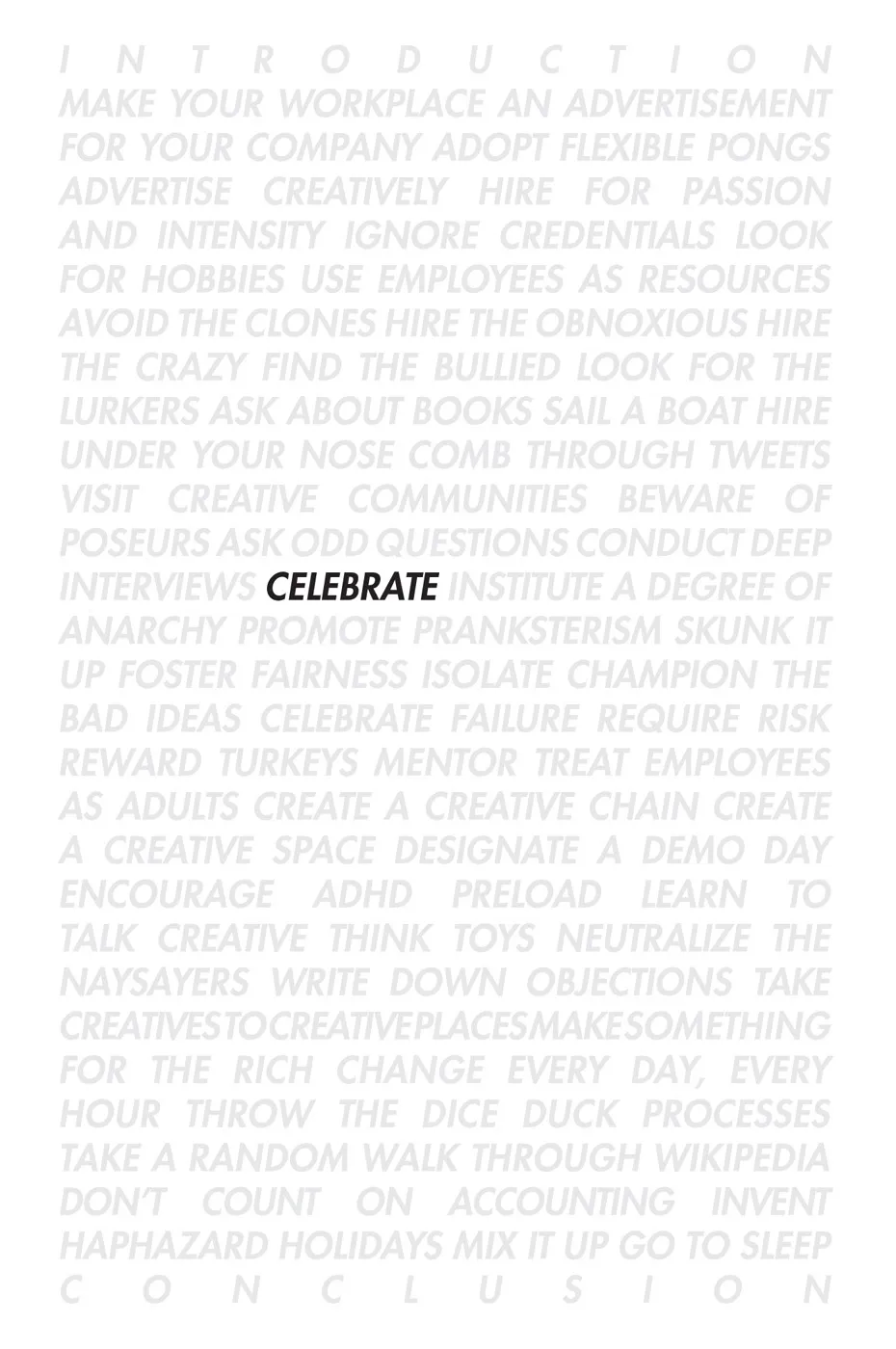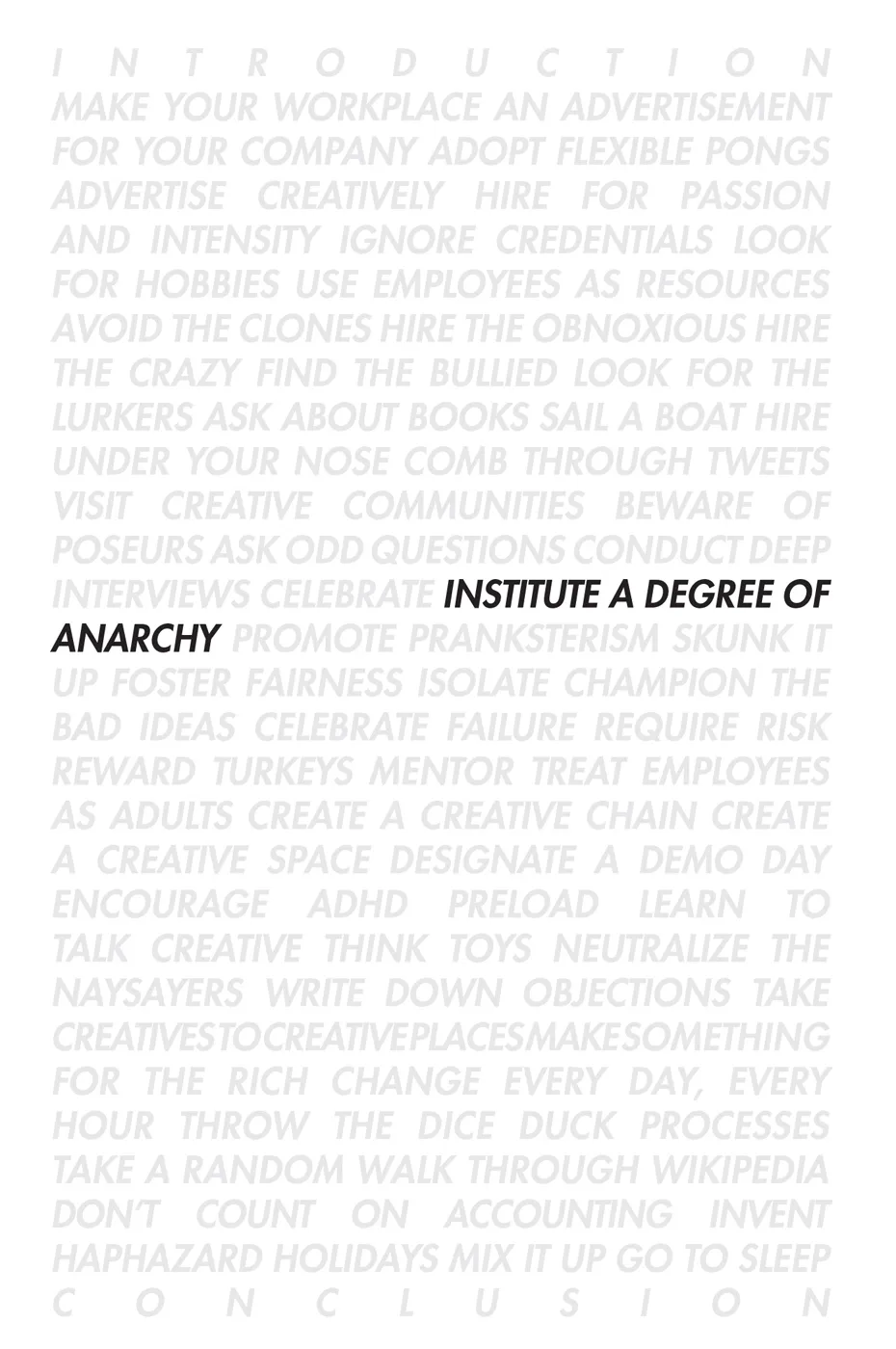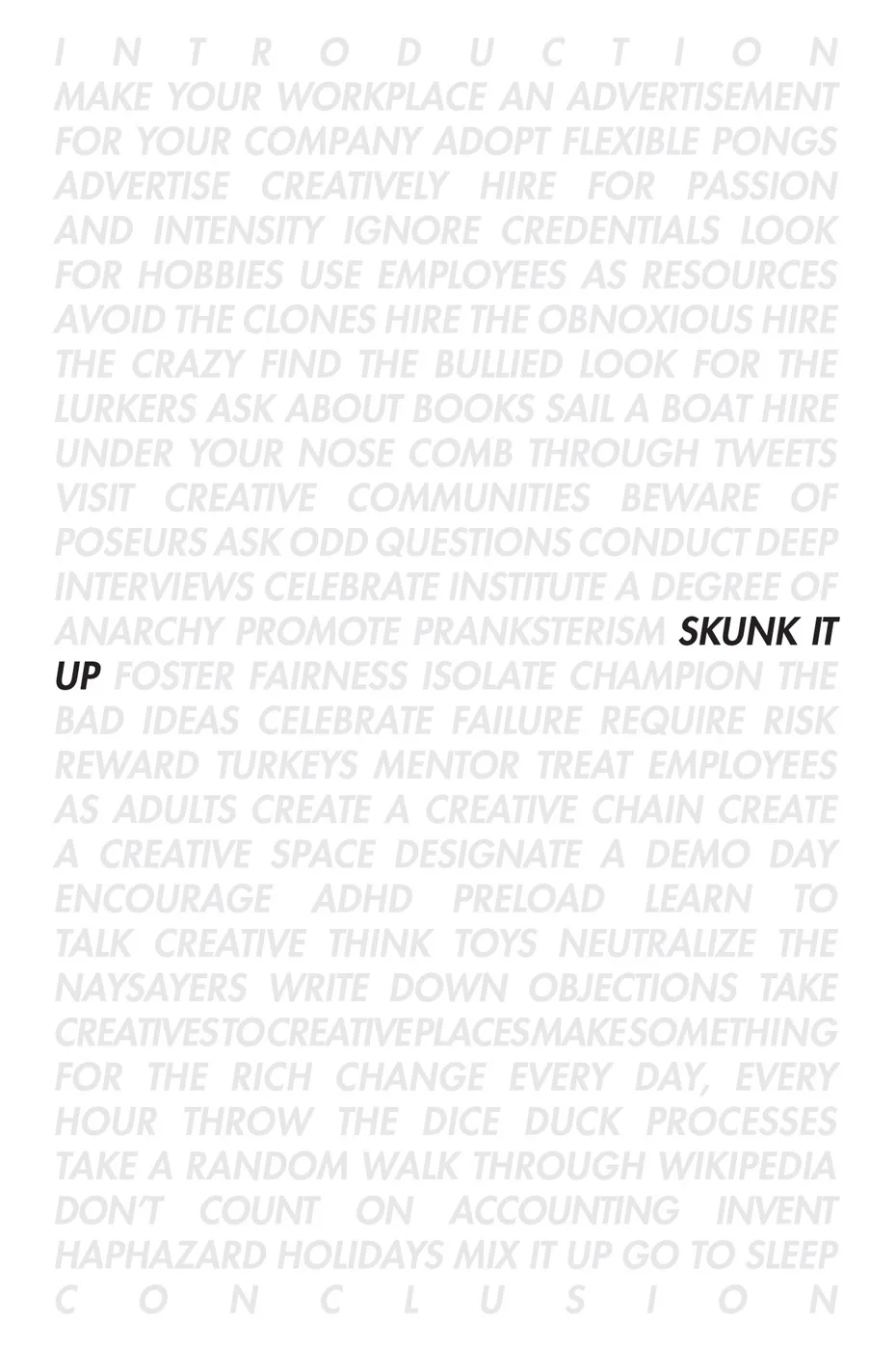![]()
KEEPING AND NURTURING THE NEXT STEVE JOBS
SECTION TWO
![]()
![]()
21
One of the best ways to keep creatives happy is to make some happiness happen. One of the best—and most cost effective—ways to do that is to throw an inexpensive party. Yes, a party. If your company can institutionalize a regular episode of genuine, collegial fun, you can create an environment where interesting people want to work—and play.
At Atari we always made sure that our employees had an opportunity to let off a little steam. Officially, the idea was that parties were to take place only when we hit our sales quota, but because we always hit quota, every other Friday we held a kegger with pizza on the back loading dock. The price: less than five hundred dollars. The result: a reputation for being a great place to work.
There was another agenda in having these festivities (besides being an advertisement for the company—see pong 1). The celebration was actually about creating informal lines of communication. Having a party lessens any sense that the company takes itself too seriously, but the real deal is that at parties, people talk to each other more freely and more candidly than while lurking in their cubicles—especially if they’ve had a little bit to drink. Ideas that might never be mentioned in the office because people were self-conscious about offering radical ideas were often brought up at our blasts. After a few beers, inhibitions often vanish.
These events worked so well that we took the idea further and occasionally threw costume parties—not only because they were fun, but because wearing costumes allows you to become who you want to be instead of who you think you should be. Hiding behind spotted animal outfits and super-hero masks makes people less self-conscious and more willing to speak up about problems—and to offer creative solutions. In other words, parties allow people to speak as themselves instead of in their carefully constructed business personas.
We also found that people sometimes came up with wonderful ideas when we asked them to stop thinking so hard and relax. There’s science behind this thinking: When you’re constantly working on a specific problem, originality often stops flowing. It’s now thought that your conscious brain can handle no more than seven or eight things at a time, but in the background, scores of additional thoughts and concepts are floating around your mind. (Bestselling author and neuroscientist David Eagleman calls the background chatter “zombie programs.”) When you relax, some of those otherwise not-so-accessible thoughts rush to the surface; therein may lie the solution to the problem you couldn’t force your brain to uncover (see pong 36).
Our attitude was that we never knew when creativity was going to strike—and at our parties it did all the time. At one particularly good bash held in our game room, people were playing one of our driving games. Everyone commented on how much more fun it would be if they could play against each other simultaneously, so one of the engineers quickly came up with an impromptu method of lashing eight of the games together. Suddenly the driving game went from a solitary experience to a social one.
It seemed an obvious move, but no one had thought about doing this before. We immediately put the game into production and called it Indy 8. Indy 8 may well have earned more money than any of our other games. In fact, there was one particular Indy 8 machine at Disney World reputed to earn one million dollars a year, one quarter at a time (or rather, eight quarters at a time).
No one had ever thought of an eight-player game before, and if this particular man hadn’t been having a good time at our party, it might never have existed.
Many other companies practice the Celebrate pong successfully, using their events to keep employees happy and increase productivity. For example, TicketKick, a company that helps Californians deal with their traffic citations, has a variety of people-pleasing tricks, such as offering personal growth classes, allowances for office decoration, and group outings when company goals are met. New employees are treated to steakhouse dinners and given tickets to Disneyland. Vans, the successful shoe and apparel manufacturer, has raffled off trips to Hawaii and sent design teams to Palm Springs, California. It also decks out its family picnics with bounce houses and zip lines. The crown jewel of the company’s headquarters in Cypress, California, is a skate bowl used for testing products as well as for blowing off steam. Similarly, San Francisco’s Benefit Cosmetics offers a wide variety of celebratory events including monthly theme parties, ice-cream socials, and group trips to baseball games.
One other advantage of the celebration: people’s tongues loosen. For example, despite Atari’s best efforts, we occasionally hired a few toxic managers, and our celebrations were generally the only place where anyone was willing to let us know about them. Several times, this is how I discovered a manager was stealing; none of his reports had the nerve to tell me until they had a beer in hand and several more in their stomach.
The best story to come out of a beer bust was the following: The wife of an employee showed up at a party and told us her husband, who worked in the purchasing department, was robbing us blind. He’d been buying tools through his brother, who was doubling the cost and taking the profit. The woman had decided to rat him out when she came to meet her husband at one of our parties and found him having sex with one of his employees.
![]()
![]()
22
Parties (see pong 21) serve still another creative function. There are few obstacles to achieving creativity in a company more intransigent than a strictly vertical organization. The more horizontal the company’s chain of command, the fewer steps from creator to CEO, the better off the company is, creatively speaking.
The beauty of parties is that they are instant hierarchy levelers—they provide an atmosphere in which anyone can communicate with anyone. Assistants can talk to executives, junior management can gossip with senior management, secretaries can chat with the chairman of the board.
At every company I founded, I did whatever was necessary to avoid an overly hierarchical organization. Hierarchy means having managers, and sub-managers, and sub-sub-managers. Basically, when you give people the title of manager, you are enabling them to say no. You want as few people saying no in the company as possible (see pongs 40 and 41).
The better model is the horizontal company at which everyone shows up to work, no one tells them what to do, and all the works gets done. This model is called directed anarchy, and it’s the best way to ensure creativity and innovation will flourish.
Most early-stage companies create this situation automatically. When you have only a few employees, you also have few rules and fewer naysayers. Many good companies try to keep that flatness as they grow, Google being a good example. At Google, you have your regular day job, but you are also allowed to spend 20 percent of your time doing whatever you want on your own. This policy enables at least a degree of directed anarchy. Even Steve Jobs let his people do a lot more than most people believe in terms of exploring various facets of their job independently.
Another example is Brisbane, California-based Ning.com, which creates custom social networks for its clients. At Ning, new employees and the executive team work together without any regard for titles or authority; furthermore, the company has a no-limit vacation policy—i.e., employees can take off as many weeks as they wish, provided they get their work done.
Jason Fried, the co-founder of Chicago’s 37signals.com, which makes web-based applications for small businesses, designed a company with a flat organization that encourages its employees to explore horizontal connections with their co-workers and learn from their relationships. Teams are given freedom to make changes to their projects, and team members lead those projects on a rotating basis. The company also tries to avoid the traditional hierarchy by hiring “craftspeople” rather than manager types.
Similarly, the leaders of the Wisconsin architecture and design firm Kahler Slater work next to its employees in an open-layout office, which the employees had a hand in redesigning. The two co-executive officers also hold open-ended discussions with employees twice a week; the company was named one of Entrepreneur magazine’s Best Small Businesses to Work for in 2011.
One of the best reasons to keep your company horizontal is that creative leaps do not always originate with your top players. Good ideas can come from assistants, janitors, part-time workers—people who are invisible in a strictly vertical company. When your company establishes that anyone can and should contribute, you will end up hearing some very good suggestions coming from unlikely places.
Froggy and Ilya Garcia were a husband-and-wife team in their seventies who worked on the Atari factory assembly line (staffed mostly by twenty-year-olds). As often as possible, I’d walk out to the production area and chat with the workers, trying to find out what was really going on. One day Froggy and Ilya told me that if we standardized certain components, we could build our product much faster. Once they explained how this would work, the solution was quite obvious to everyone. But no one else had noticed it. By implementing the Garcias’ changes, we probably ended up saving forty dollars a machine.
![]()
![]()
23
Way back in the late twentieth century, airports used to have big display ads under which sat multiple buttons. If you pushed one, you were immediately connected to some kind of service, say, a motel or a car-rental company. Late one night, Steve Wozniak decided to have some fun: He drove to the San Francisco airport and reprogrammed some of these services, switching out the companies’ phone numbers with those of his friends. In the middle of the night, Steve’s buddies started getting phone calls from people with questions such as “Do you have anything in midsize?” and “How much do you charge for a room?”
Steve Jobs was also something of a phone prankster, although one of his favorite tricks was more practical. He (with Wozniak) would engineer so-called blue boxes that could emulate the series of tones the telephone company used to code long-distance calls, making it possible for him to call anywhere he wanted in Europe for free. (Remember, at the time, transatlantic calls were quite expensive.) If you look at the spectrum of rule followers and rule breakers, socially acceptable rule breaking is irreverent, creative, and good-natured. Socially unacceptable rule breaking is not. You don’t want to hire felons; companies that recruit from prisons don’t do well. But good pranks are fun, distracting, make people laugh, and if they’re really inventive, they expose someone’s folly and help correct it.
A friend told me a story about a smart journalist who wrote a successful book a few years ago and started taking himself far too seriously. So his friends at the newspaper where he worked devised an ingenious prank: They fooled him into thinking he was being interviewed for a radio program and called him, asking all kinds of ridiculous and pretentious questions—to which he responded with all kinds of ridiculous and pretentious answers. The journalist then received the tape in the mail. No one said anything further, but his arrogance level dropped immediately.
One of my favorite pranks from the Atari days happened to a guy who constantly talked about his golf game. So one day his friends replaced all the furniture in his office with actual sod and a golf pole. When he opened the door to his office the next morning, all he saw was a putting green. He significantly curtailed talk of his golf prowess.
Humor is necessary in the workplace, and pranks help people learn to laugh at themselves. People who are pompous and pretentious are not risk takers; they are not as creative. A prankster culture loosens up employees. Groupon, the Chicago-based, six-billion-dollar online social-coupon company, has a notorious prankster in its CEO and co-founder, Andrew Mason. Mason has been known to pull a wide variety of pranks, such as giving office space to a nonexistent person. He also reportedly hired a performance artist to gallivant around the company’s Chicago offices in a tutu.
Online shoe retailer Zappos has created a culture where pranks are not only accepted, but also celebrated. One of the company’s ten core values is to “Create fun and a little weirdness.”
Think of pranks as a dress rehearsal for creativity on the job.
Caveat: Don’t go too far.
![]()
![]()
24
As companies grow, they also tend to balloon in terms of paperwork, logistics, and hierarchies. At the same time, they tend to shrink in creativity and originality. Generally speaking, when a company reaches about 150 employees, sclerosis sets in. Once there are too many people for everyone to know each other’s names, what they do, and how they do it best, the calcification intensifies. Pennies start being watched, speed to market slows down, entrepreneurship disappears, and soon your organization is basically just another big company.
One good manner of avoiding such rigidity is to branch off. This doesn’t mean creating a subsidiary. Instead, create a subsidiary location. Rent another site and let people work there, away from the bureaucracy, away from the stagnation. All you need to do is water them a little, let them take root, and watch them grow their own culture.
In the 1940s, aerospace company Lockheed created a special branch and called it Skunk Works. It was enormously successful, and the name stuck. Today the term describes any group within an organization that is given a high degree of autonomy and whose mission is to work on advanced or secret projects. Sometimes companies give it a different name: Google’s skunkworks is called Google X. At Google X, employees are working on special projects such as driverless cars and space elevators—although the precise nature of what Google X is doing is kept so confidential that most Google employees themselves don’t even know. Similarly, now that the company has bought Motorola, it is planning to create an Advanced Technology and Projects Division within the company; this division will convene a small group ...




